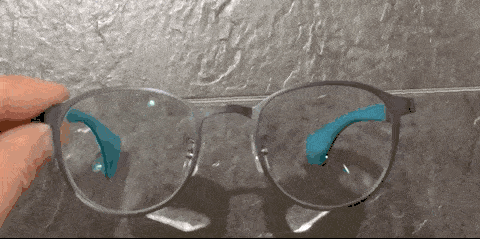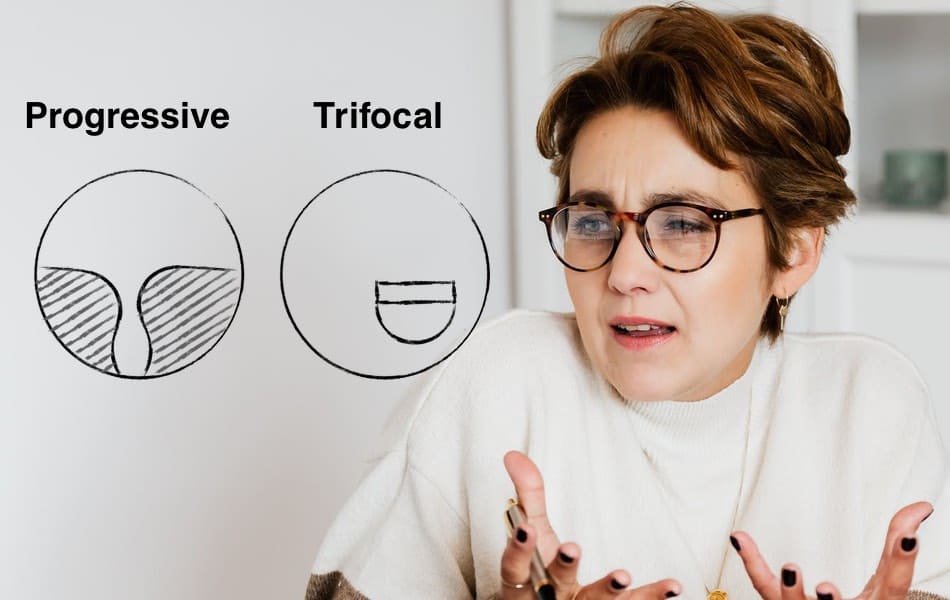Here in this article, you will learn about the differences in progressive lenses vs trifocal lenses.
The differences in trifocal lenses vs progressive lenses lays in the aesthetics and the way you see through both types of lens designs.
| Progressive Lenses | Trifocal Lenses | |
| Visible Line | No | Yes |
| Image Jump | No | Yes |
| Bigger Fields of View | Less field of view, size depends on Add value too | Biggest field of view possible |
| Blurry fields | yes in the lower half left and right from the reading zone. Depends on the Add value too | No |
| Bent Shapes | more possible the higher the ADD value | Depends on your prescription, in most cases no |
Both Lens designs are needed for people over 50 years old. In this age presbyopia really forces the people read things with their arms more extended. Because when you extend your arm your eyes need to adapt less to the reading distance. And that gets harder when you have presbyopia.
Luckily there are progressive lenses and trifocal lenses to correct your vision. But as you age over time so set changes in when it comes to the field of view in progressive lenses. Let us see how they change over time compared to trifocal lenses.
The Field of View in Progressive Lenses vs Trifocal Lenses
When it comes to the field of view in combination with with a decent reading zone nothing beats trifocal lenses. The field of view can literally as wide as the lens goes in the frame. Those lenses are called Franklin Style Trifocals.
This way you could perform very wide horizontal eye movements to read a book. With progressive lenses in comparison this not possible. When it comes to progressives performing eye movements to the sides will produce blurry vision.

You can point your nose into the direction you want to see clearly in but headmovement is a common thing if you are used to progressive lenses. In progressive lenses the additional lens power for reading is distrubuted in the lower half of the lenses in a corridor that is only a few millimeters wide.
As you age your lens power for reading needs to be higher. With this increase of lens power you will lose clear width in the corridor. What you can expect so see clearly with progressive lenses are approximately 2-3 columns of articles in a news paper.
With trifocals you are not that restricted. Even in the smaller trifocal lens designs you will get 28mm of clear horizontal width out of the lens. This is just not possible with normal progressive lenses. Even not with the very high end ones.
What About the Blurry Fields of View When It Comes to Progressive Lenses vs Trifocal Lenses
There are no blurry fields in trifocal lenses. This the good part about trifocals. Every part of the lenses can actually be used. But when it comes to progressive lenses these things change. A big part of progressive lenses is not usable for you because surface astigmatism makes things blurry.
Down below in the picture you can see the blurry fields in progressive lenses illustrated by the grey color. Notice under each picture stands another value. This Add value increases from 40 years old with approximately 0,75D to 65 years old in combination with Add +2,25D

This means over time your field of view will get a little more restricted with each progressive lens. In Trifocals you can choose the lens design and it stays that way as you buy it again.
Image Jumps
You do not need to deal with image jumps when you use progressive lenses. It is a very smooth experience switching from distance vision to reading.
However when it comes to trifocals you need to deal with image jumps. This means when you switch from distance vision into another part of the lens like the mid section or the reading section picture you see makes a little hop.
Depending on the lens design you choose for the trifocals you get a bigger or smaller image jump. The reason is the position of the optical center in in the reading field. The more distance this center has to the adjacent lens section the bigger the jump will be and vice versa.
This is something people get used to after using the trifocal for a few days.
Bent Shapes in Progressive Lenses and Trifocals
As you can see in this short clip below the lines get bent heavily as the line moves in the lower half of the lenses. Those are progressive lenses. And this is where the blurry fields are located. The higher the ADD value the worse those perceptions get.
You can minimize them little by a perfect fit, a smaller vertex distance and very high end lenses but they still will be there. Though I have to admit you will not see them as drastically demonstrated in the clip.

The reason therefor is the position looking on the lenses instead of having them on your nose. But in some cases people do see things quite bent.
When having trifocal lenses in most cases you do not have to deal with this type of distortions. Although if your needed lens power is high you could experience some kind of this. But at a smaller scale.
Visible Lines
Of course when it comes to progressive lenses you do not need to deal with visible lines. You get an very smooth transition from distance vision to the reading zone but with the trade of the smaller field of view.
A similar trade-off needs to be made if you extend the reading segment in trifocal lenses. The reason is the thickness of the lens segments changes more the bigger the reading segment gets. This means the ledge gets bigger in trifocal lens designs with a bigger reading segment leading to a more visible line.
You can not get rid of the ledge with the big trifocal lenses. This is something you should know first. Because some people are stressed by the dust for example that accumulates on the ledge.

Those tiny spots are definetly not as easy to clean as a smooth lens surface form a progressive lens.
In my opinion there are two types of customers. The first one can not even imagine how someone can restrict there eye moments by the blurry fields of view in a progressive lens design.
The second type of customer can also not imagine how someone buys lenses with visible lines on it. Because fashion wise this is a no go. And those are the lenses for old people.
So here is my advice. Look at the dummy lenses in the store and test them. If you are a person who loves the bigger field of view for work with little detailed stuff and you see the benefits of trifocal but actually you do not want a visible line just get both.
I mean there is no such thing as the one perfect lens design for all the activities.
I hope this little comparison made your decision easier when it comes to trifocals or progressive lenses.
I wish you a great day
